This state is home to many animals and wildlife that live in North Dakota’s three unique regions. These include the Red River Valley in the east, the scenic Drift Prairie, and the rugged Missouri Plateau.
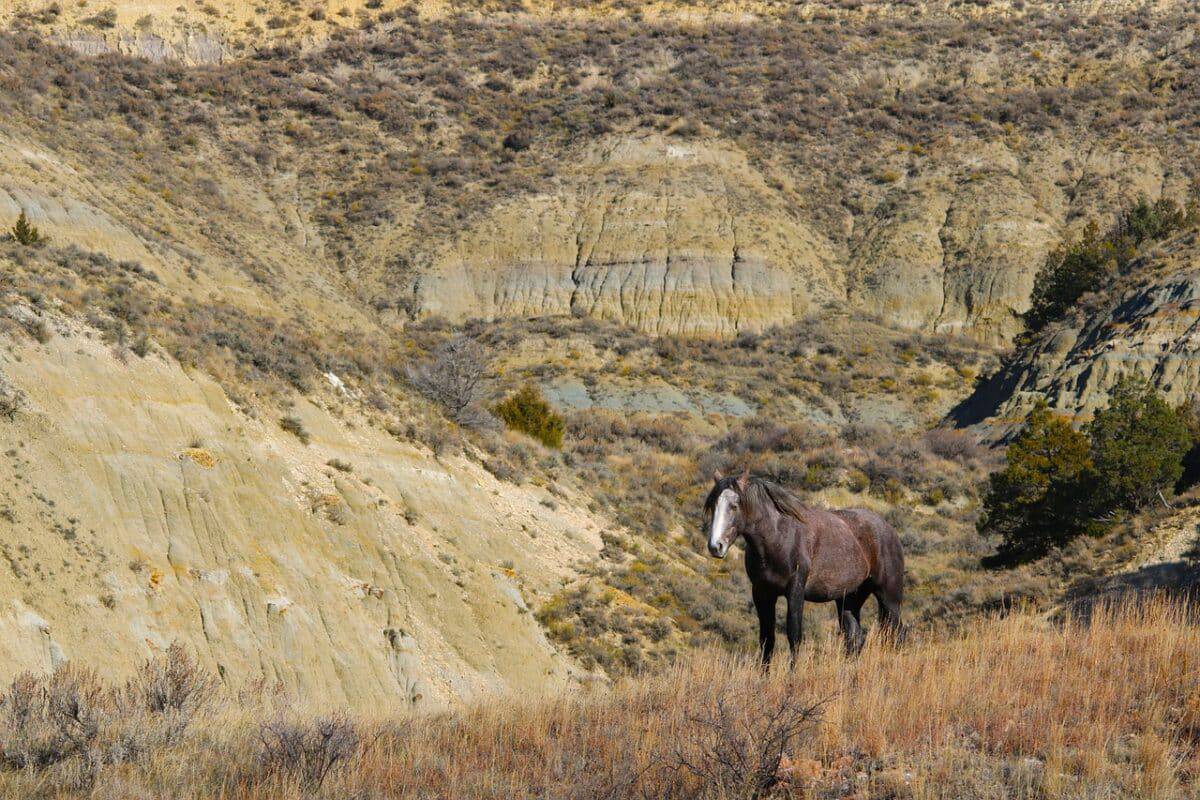
Learn more about Animals in North Dakota in this guide. You can jump to any section or read the entire article below.
Key Points
| Animal | Key Points |
|---|---|
| Bighorn Sheep | – Varies in size and appearance depending on the species – Occupies diverse habitats, including mountains, rocky slopes, and grasslands – Herbivorous diet, primarily feeding on grasses and shrubs – Lives in herds and has different breeding seasons depending on the species |
| Mink | – Native to North America and found across Canada, the United States, and parts of Mexico – Sleek and slender body with dark brown fur – Adapted to various aquatic and semi-aquatic habitats – Carnivorous diet, feeding on fish, amphibians, small mammals, birds, and crustaceans – Least Concern conservation status |
| Piping Plover | – Small shorebird found along the Atlantic coast and Great Lakes region of North America – Breeds in tundra and Arctic coastal areas – Feeds on insects, small crustaceans, marine worms, and other small invertebrates – Undertakes remarkable long-distance migrations – Near Threatened conservation status |
| Common Snapping Turtle | – Large freshwater tutle found in North America – Inhabits freshwater habitats such as lakes, rivers, ponds, and marshes – Opportunistic omnivore, feeding on a variety of prey – Known for its powerful bite and defensive behavior – Least Concern conservation status |
| Red Knot | – Medium-sized shorebird found on all continents except Antarctica – Breeds in Arctic regions and winters along coastal areas – Feeds on invertebrates such as mollusks, worms, crustaceans, and insects – Remarkable long-distance migratory bird – Near Threatened conservation status |
All about Wildlife in North Dakota
In North Dakota, you’ll find vast farmlands stretching across the Red River Valley and drift prairie, offering expansive grasslands for animals to roam. And hold on to your hats, because at the Missouri Plateau, you’ll discover mountains bordering the Montana region. Who knew North Dakota had a touch of mountain majesty?
Now, while North Dakota may not be known for its forests, it compensates with wetlands, rivers, flood plains, and even some dry stretches called badlands. Talk about variety! Thanks to its central location in North America, North Dakota experiences a range of seasons, from long winters to hot summers. And that means a wide variety of animals call this place home.
Keep your eyes peeled for moose and bison casually crossing the roads. White-tailed deer, raccoons, beavers, and ferrets can be found in forested areas or grasslands. Oh, and don’t forget about the significant predators like mountain lions, Velox (coyotes), bighorn sheep, elk, and red foxes. It’s a real wildlife extravaganza!
Rodent enthusiasts, rejoice! North Dakota has beavers and black-tailed prairie dogs doing their thing in the grasslands, one of which is endagered, read our article about the 21 Most Endangered Animals In North America to discover more.
With numerous lakes and water areas, you’ll be treated to a symphony of birdlife, including piping plovers and long-billed curlews. The North Dakota region is truly a haven for feathered friends.
In fact, North Dakota boasts a whopping 63 wildlife areas, more than any other state. From the Lake National Wildlife Refuge to the Lostwood National Wildlife Refuge, and from Arrowwood National Wildlife to Theodore Roosevelt National Park, these areas teem with animals, grasslands, and wetlands. It’s a wildlife lover’s dream come true!
So, get ready to explore the animal kingdom in North Dakota, where creatures roam freely and wildlife abounds. With its abundant wildlife areas and incredible biodiversity, North Dakota offers an unforgettable experience for nature enthusiasts like you. Let’s dive into the wilderness and embrace the untamed beauty of this remarkable state!
Bighorn Sheep
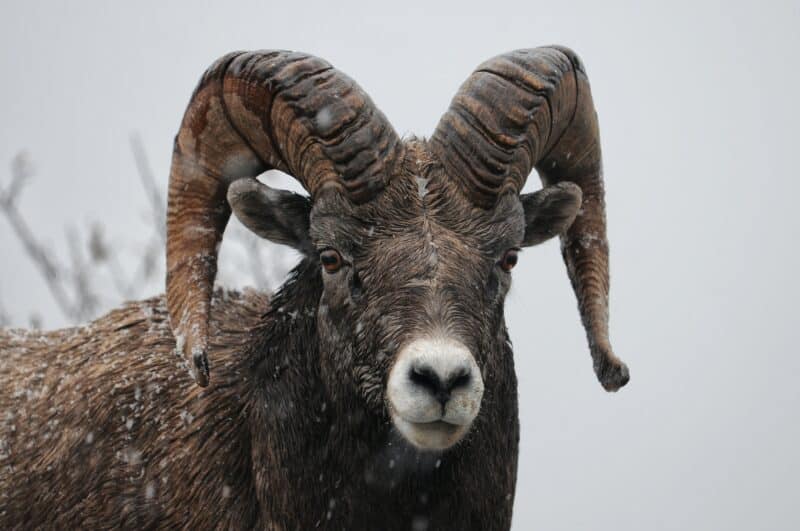
| Category | Information |
|---|---|
| Scientific Name | Varies depending on the species |
| Common Name | Bighorn Sheep |
| Size | Length: Varies depending on the species |
| Height at Shoulder: Varies depending on the species | |
| Weight: Varies depending on the species | |
| Body Shape | Stocky body with short legs and a muscular build |
| Horns | Both males and females have horns |
| Horns are large, curved, and vary in shape depending | |
| on the species and individual | |
| Fur Color | Coloration varies depending on the species and |
| can include shades of brown, gray, or white | |
| Distribution | Bighorn Sheep species are found in various regions |
| of North America, including mountainous areas | |
| Habitat | Occupies diverse habitats, including mountains, |
| rocky slopes, and grasslands | |
| Diet | Herbivorous, primarily feeding on grasses, |
| shrubs, and other vegetation | |
| Social Behavior | Lives in herds, with males often forming separate |
| bachelor groups during non-breeding seasons | |
| Reproduction | Breeding Season: Varies depending on the species |
| Gestation Period: Approximately 6 months | |
| Litter Size: Usually one or two lambs | |
| Conservation Status | Varies depending on the species |
| Some populations are listed as endangered or | |
| of conservation concern |
These magnificent creatures are known for their muscular build and impressive horns adorning their heads. Picture a majestic beast with chocolate brown fur, weighing around 73 to 113 kilograms. The males tend to be heavier than their female counterparts, who weigh about 159 kilograms. Standing at around 40 inches tall from the shoulder, their eyes positioned forward provide them with excellent vision. They possess sharp eyesight, acute hearing, and a keen sense of smell, helping them find food and stay safe from predators.
North Dakota is home to the bighorn sheep, one of the two wild sheep species found in the region. These magnificent creatures sport large horns on their heads, making them quite the sight to behold. It’s worth noting that the bighorn sheep is considered one of the subspecies of wild sheep, with other subspecies including the Rocky Mountain bighorn sheep, Sierra Nevada bighorn sheep, and California bighorn sheep.
Male bighorn sheep, called rams, sport impressive curved horns weighing around 14 kilograms. As they grow older, their horns become even more massive, reaching lengths of 0.9 meters and a circumference of approximately 0.3 meters at the base. Female sheep, known as ewes, have shorter horns. Both rams and ewes use their horns for feeding and battling with other animals.
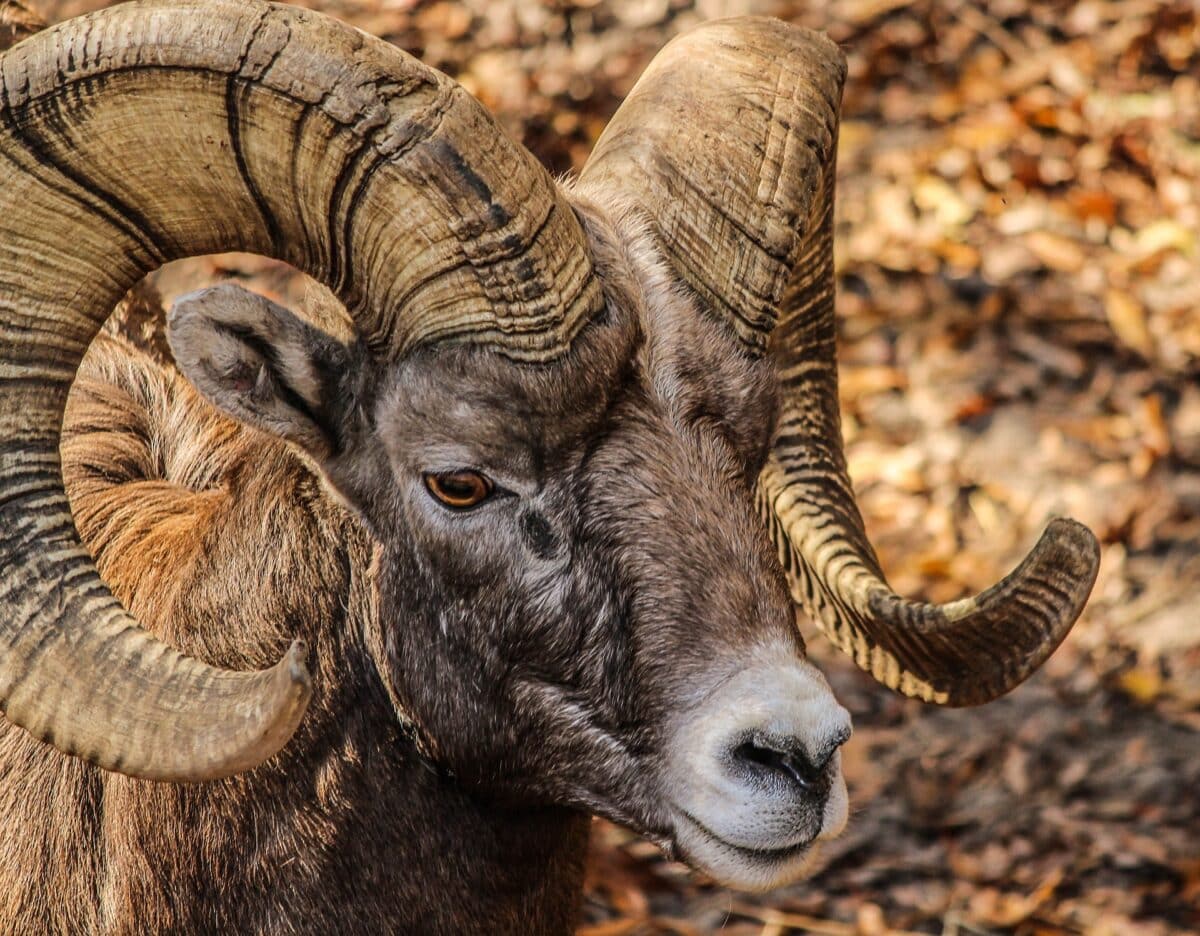
While not the most agile climbers, wild sheep are remarkably skilled at scaling rocky terrain, which aids in their defense against predators. During the summer, they graze on clover, sedges, and grasses, while in the winter, they rely on woody plants like sage and willow. In desert areas, they can even feast on cacti. Their stomachs are divided into four sections, allowing for efficient digestion and chewing of food.
Impressively, wild sheep have a remarkable ability to absorb large amounts of water, enabling them to survive for extended periods without access to water sources. Males typically prefer solitary living rather than forming groups with females and younger sheep. The young ones stay with their mothers and gradually join groups led by older ewes.
Their lifespan can vary based on factors such as climate and environment. Generally, wild sheep can live up to 10 years, while females may reach up to 15 years, depending on the population, area, and surroundings they inhabit.
So, prepare to be awestruck by the grandeur of North Dakota’s wild sheep. From their majestic horns to their impressive survival adaptations, these creatures are a true marvel of the animal kingdom. Let’s explore their world and discover the wonders they hold!
Where to find Big Horn Sheep in North Dakota
They are found in the west mountain region of North Dakota. They mostly live in mountain regions, so that they can be easily found in mountain areas. Big horns are prey to mamanyey and can easily be found in grassland areas in the summer and winter; they can beselterwinterother animals in North Dakota. They are located in steep badland regions along with Little Missouri River.
Mink
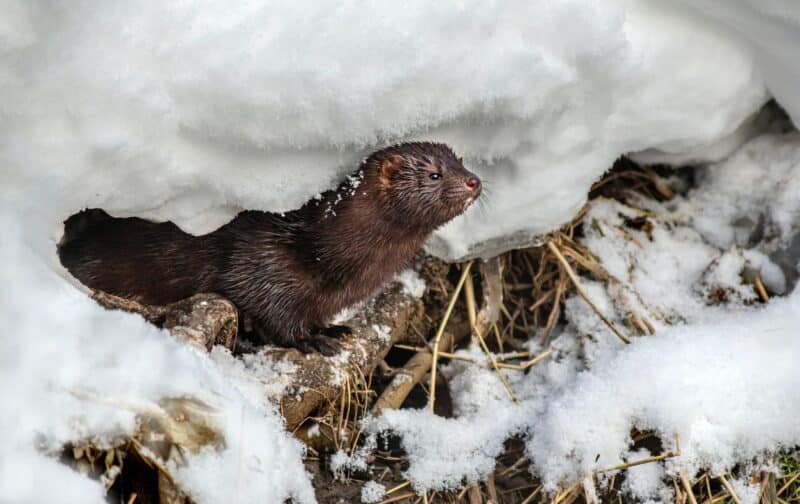
| Category | Information |
|---|---|
| Scientific Name | Neovison vison |
| Common Name | American Mink |
| Size | Length: 19 to 28 inches (48 to 71 cm) |
| Height at Shoulder: Around 7 inches (18 cm) | |
| Weight: 1.5 to 3 pounds (0.7 to 1.4 kg) | |
| Body Shape | Sleek and slender body with short legs |
| Fur Color | Dark brown with a lighter underbelly and a white chin |
| Distribution | Native to North America, found across Canada, |
| United States, and parts of Mexico | |
| Habitat | Adapted to various aquatic and semi-aquatic habitats |
| such as rivers, lakes, marshes, and coastal areas | |
| Diet | Carnivorous, feeding on fish, amphibians, |
| small mammals, birds, and crustaceans | |
| Activity Pattern | Primarily crepuscular and nocturnal |
| Reproduction | Breeding Season: Late winter to early spring |
| Gestation Period: Approximately 40 to 75 days | |
| Litter Size: Typically 4 to 6 kits | |
| Conservation Status | Least Concern |
| Considered a species of least concern by the IUCN | |
| although some local populations may face | |
| threats such as habitat loss and pollution |
These carnivorous creatures are known for their dark-colored fur and semiaquatic nature. They belong to the Neogale and Mustela genera, alongside their relatives such as weasels, ferrets, and otters.
There are two subspecies of minks: the American Mink and the European Mink. Unfortunately, both subspecies are currently endangered due to the demand for their fur in the fashion industry. These larger mink species have faced significant hunting pressure, pushing them closer to extinction.
Male minks weigh around 1 kilogram and can reach up to 60 centimeters in length, with some individuals reaching 3.2 kilograms in weight. Female minks are smaller, weighing approximately 600 grams and measuring around 50 centimeters in size. Their tails range from 12.8 to 22.8 centimeters in length, not included in the overall measurements. Minks have a silky brown-to-black coat, with some individuals displaying a white coloration. The fur is fine, with dark brown coloring on the upper body and white underparts.
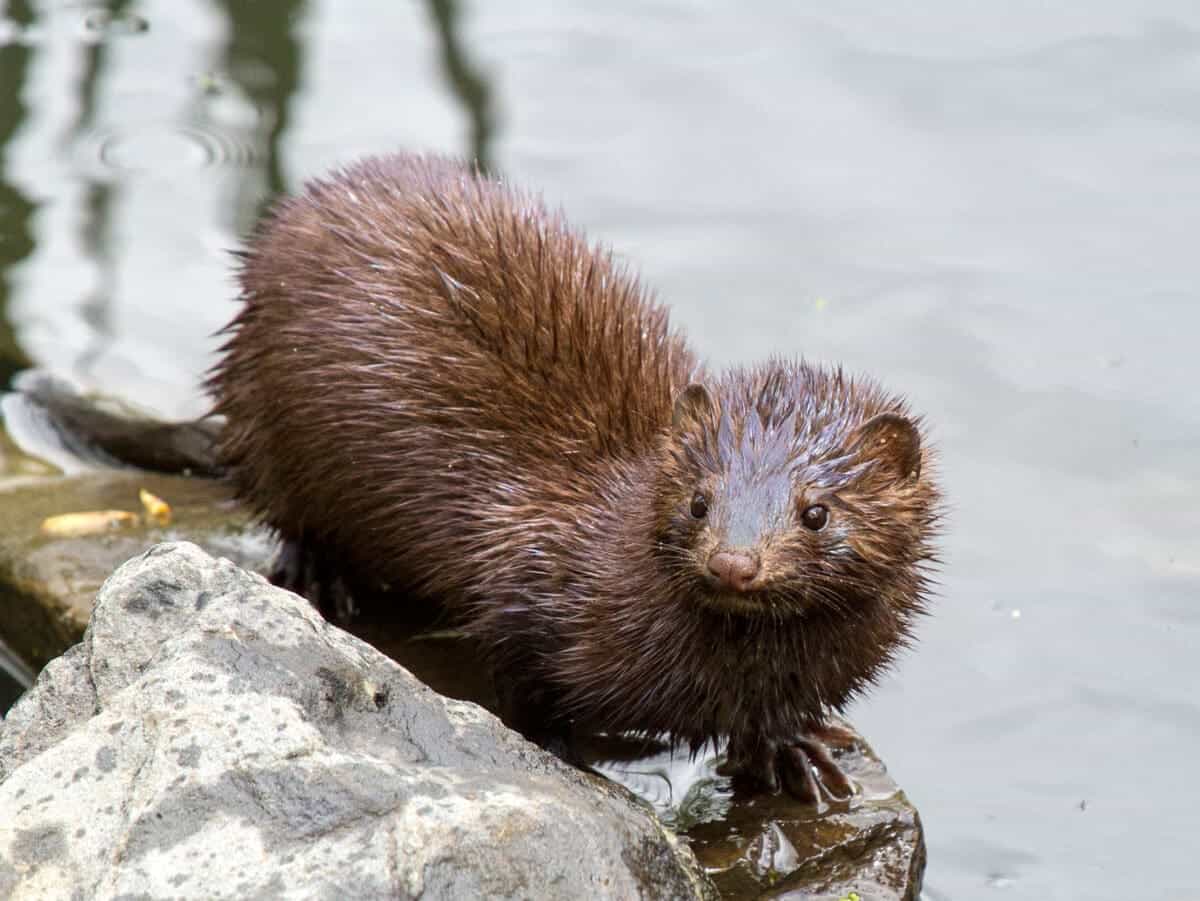
During a gestation period of around 39 days, the development of the female mink’s embryos pauses for a period of 76 days before the birth of the baby minks. Typically, a litter consists of 6 to 10 babies, and they take around 45 to 52 days to reach independence. Minks have a lifespan of about 10 years but can live up to 3 years in the wild. Their diet primarily consists of fish, other aquatic animals, birds, and eggs. Minks living on farms may have a diet that includes cheese, meat, fish, eggs, dog food, and commercial foods.
These playful creatures love to reside near water areas such as lakes, marshes, and riverbanks. You may catch them following streams as they explore their surroundings and engage in their playful antics. Keep your eyes peeled, as minks are often visible during their adventurous escapades.
So, prepare to be captivated by the world of minks, these fascinating and agile semiaquatic animals. From their dark fur to their love for water, they are truly unique creatures. Let’s venture into their habitat and discover the wonders of minks in action!
Where to find Minks in North Dakota
They love to live near water areas like rivers and follow streams so they can be found around them. They are located very quickly in the North Dakota region, especially in the Eastern half.
Piping Plover
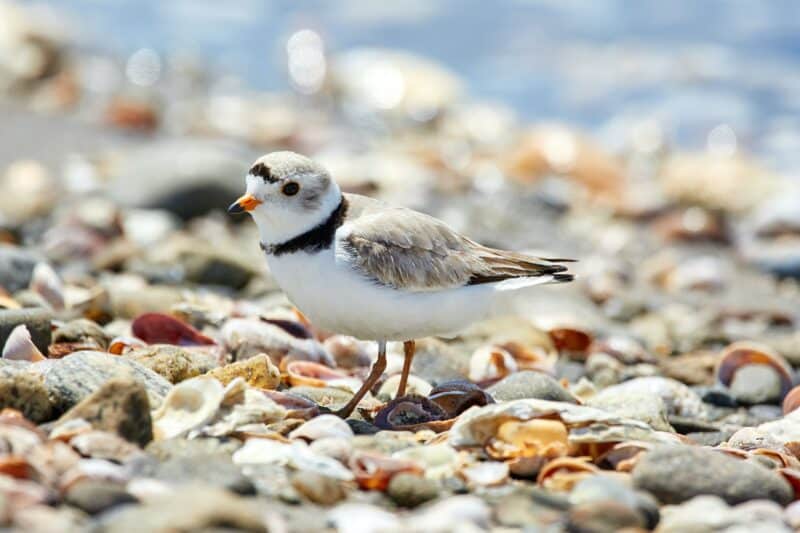
| Category | Information |
|---|---|
| Scientific Name | Charadrius melodus |
| Common Name | Piping Plover |
| Size | Length: 5.5 to 7 inches (14 to 18 cm) |
| Wingspan: 13 to 15 inches (33 to 38 cm) | |
| Weight: 1.2 to 2 ounces (34 to 57 grams) | |
| Body Shape | Small shorebird with a rounded body and short legs |
| Plumage | Pale sandy or pale gray-brown upperparts |
| White underparts with a dark breast band | |
| Distribution | Breeds in North America, primarily along the |
| Atlantic coast and Great Lakes region | |
| Winters along the southern coasts of the United States | |
| Habitat | Nests on sandy beaches, sandbars, and coastal dunes |
| Diet | Carnivorous, feeding on insects, small crustaceans, |
| marine worms, and other small invertebrates | |
| Reproduction | Breeding Season: Late spring to early summer |
| Nest: A shallow scrape on the ground | |
| Clutch Size: Typically 4 eggs | |
| Conservation Status | Near Threatened |
| Faces threats such as habitat loss, disturbance, | |
| and predation |
These small birds, reminiscent of shorebirds, can be found near coastal areas and beaches in North America. Sporting a sand-like coloration, they blend seamlessly into their surroundings. Adult plovers showcase striking yellow, orange, and red legs, with a distinctive black band extending from their eyes to their forehead. A black line encircles their breast area, while males possess thick black stripes near their chests, making it easier to distinguish between males and females.
Plovers can be quite challenging to spot when they’re standing still, as their excellent camouflage allows them to blend into the sandy beach regions. When in motion, they move swiftly in short bursts, making it even more difficult to keep track of them. There are two main species of plovers: the Charadrius melodus, found in the eastern region, and the circumcinctus, found in the Midwest.
With a population estimated to be around 7,600 to 8,400, plovers are relatively small in number, and their growth rate is slow. They have round, large heads, short necks, and thick bills. During the non-breeding season, they develop black markings on their chests, aiding in differentiating between males and females. Their bills are orange, with a black tip.
Plovers measure about 15 to 19 centimeters in length, with a wingspan ranging from 35 to 41 centimeters. They weigh between 42 and 64 grams. These fascinating birds prefer sandy beaches and arid water areas. You can spot them along the Atlantic coast of the United States, as well as ocean and bay beaches near the Great Lakes region. While they are rarely seen outside their sandy habitats, they become more visible during migration periods. In the winter, they migrate south to the Bahamas, seeking warmer climates.
Plovers truly capture the beauty of nature, showcasing their remarkable adaptations and unique appearances. From their sand-colored plumage to their swift movements along the coastline, they leave us in awe. Let’s keep our eyes peeled for these elusive yet captivating birds during their migrations and appreciate their presence in the natural world!
Where to find Piping Plover in North Dakota
They are mainly viewed in migration season. They are found in the Prairie Pothole Region of North Dakota. They are primarily found in wetland areas and are very rare to see on the outside of sand lands. Found at Sandland, sand bars, gravelly beaches, and other animals in North Dakota.
Common Snapping Turtle
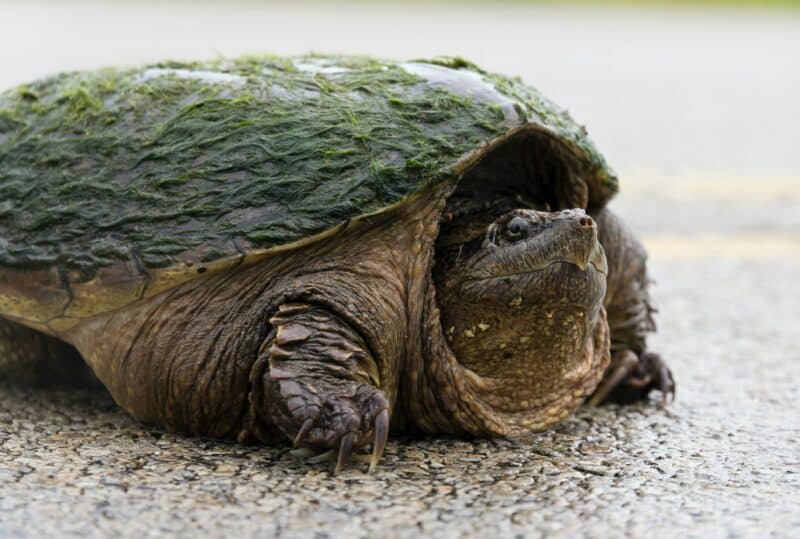
| Category | Information |
|---|---|
| Scientific Name | Chelydra serpentina |
| Common Name | Common Snapping Turtle |
| Size | Shell Length: 8 to 18 inches (20 to 46 cm) |
| Weight: 10 to 35 pounds (4.5 to 16 kg) | |
| Body Shape | Large, robust body with a large head and long tail |
| Shell | Rough, keeled shell with three prominent ridges |
| Tan to dark brown coloration | |
| Distribution | Native to North America, found from southern Canada |
| to northern Mexico | |
| Habitat | Inhabits freshwater habitats, including lakes, |
| rivers, ponds, and marshes | |
| Diet | Opportunistic omnivore, feeding on a variety of |
| prey such as fish, amphibians, insects, plants, | |
| and carrion | |
| Behavior | Typically solitary and aggressive when threatened |
| Known for its powerful bite and defensive behavior | |
| Reproduction | Breeding Season: Spring to early summer |
| Females lay eggs in sandy or gravelly areas | |
| Clutch Size: Typically 20 to 40 eggs | |
| Conservation Status | Least Concern |
| Considered a species of least concern by the IUCN | |
| although local populations may face threats |
They are known as one of the biggest species of freshwater turtles. They are found in southeast Canada, southwest mountain areas, Nova Scotia, and Florida. There are around three species of these turtles, and are generally named the common snapping turtles. They are a commons sight and it isn’t hard to spot a snapping turtle.
These impressive creatures possess mighty jaws and have remarkable mobility in their head and neck. While they can live both underwater and on land, they have a strong affinity for aquatic habitats. Snapping turtles are adept at hiding and fleeing underwater, utilizing their ability to stay submerged. With a lifespan ranging from 15 to 20 years, their longevity may vary depending on the specific habitat and environmental conditions. Interestingly, there have been reports suggesting that some snapping turtles can live up to 100 years, with data supporting this found in Algonquin Park in Ontario, Canada.
Snapping turtles can exhibit aggression and fear when faced with unfamiliar situations, including encounters with humans. In such circumstances, they may become curious and use their noses to bump into others as a means of establishing distance from potential disturbances. They prefer finding shelter in muddy areas or grassy habitats nearby. These versatile creatures have a diverse diet, consuming both plants and animals, making them vital contributors to aquatic ecosystems.
When it comes to hunting, snapping turtles excel. They prey on frogs, fish, reptiles, and small mammals, demonstrating their impressive skills as hunters. Their feeding behavior is notable, as they can swallow their food whole, similar to snakes. Being omnivorous, they also consume carrion and various underwater vegetation.
With their fascinating behaviors and adaptations, snapping turtles play a significant role in maintaining the balance of aquatic habitats. Let’s marvel at their incredible hunting abilities and appreciate their contributions to the natural world!
Where to find Common Snapping Turtle in North Dakota
Two species of snapping turtle are found in the North American region. One is the Common snapping turtle located in the North Dakota region (mainly in freshwater parts) and the south and southwest regions of America. They are widespread and can be found very quickly in North Dakota. If you take a hike across Dekota you will most likely spot a snappign turtle!
Red Knot

| Category | Information |
|---|---|
| Scientific Name | Calidris canutus |
| Common Name | Red Knot |
| Size | Length: 9.8 to 10.6 inches (25 to 27 cm) |
| Wingspan: 20 to 23 inches (50 to 58 cm) | |
| Weight: 3.5 to 5.3 ounces (100 to 150 grams) | |
| Body Shape | Medium-sized shorebird with a plump body and short legs |
| Plumage | Breeding Plumage: Bright rusty red on the head, neck, |
| and breast with a pale underbelly | |
| Non-breeding Plumage: Grayish-brown with a mottled | |
| appearance | |
| Distribution | Global Distribution: Found on all continents except |
| Antarctica | |
| Breeding Range: Arctic regions of North America and | |
| Eurasia | |
| Wintering Range: Coastal areas of North and South | |
| America, Africa, and Australasia | |
| Habitat | Breeds in tundra and Arctic coastal areas |
| During migration and winter, frequents sandy beaches, | |
| mudflats, and estuaries | |
| Diet | Omnivorous, feeding on a variety of invertebrates, |
| including mollusks, worms, crustaceans, and | |
| small insects | |
| Migration | Remarkable long-distance migratory bird |
| Undertakes annual migrations between breeding and | |
| wintering grounds, covering thousands of miles | |
| Conservation Status | Near Threatened |
| Faces threats such as habitat loss, climate change, | |
| and disturbance along migratory routes |
Red knots are stout and well-proportioned sandpipers that showcase stunning plumage, with splendid earthy orange underparts and a complex blend of gold, buff, and dark hues on their upper parts during the summer. Red Knots are a cosmopolitan species found on all continents, except Antarctica. They undertake impressive migrations, traveling vast distances from breeding areas in the Arctic to wintering spots in southern South America, Africa, and Australia. Although this is impressive you can read about an even more awe-inspiring bird by checking out an article about the Epic Journey Of The Arctic Tern.
Unfortunately, Red Knot populations from eastern North America have experienced significant declines in recent years due to excessive harvesting of horseshoe crab eggs. As a result, they have become a flagship species for shorebird conservation in the twenty-first century.
Red Knots primarily rely on their keen eyesight while foraging, but they can also probe into sand or mud, utilizing their sense of touch to locate invertebrates beneath the surface. Their bill tips are equipped with specialized tactile organs called Herbst corpuscles, which detect differences in pressure, providing valuable cues that a delectable meal is nearby.
Like many birds, Red Knots possess a uropygial gland, also known as the preen gland, located at the base of their tail. They use this gland to secrete waxy oil, which they spread over their feathers during preening. This waxy coating serves as a protective barrier. As the breeding season approaches, the chemical composition of the wax changes, making it less detectable to mammalian predators.
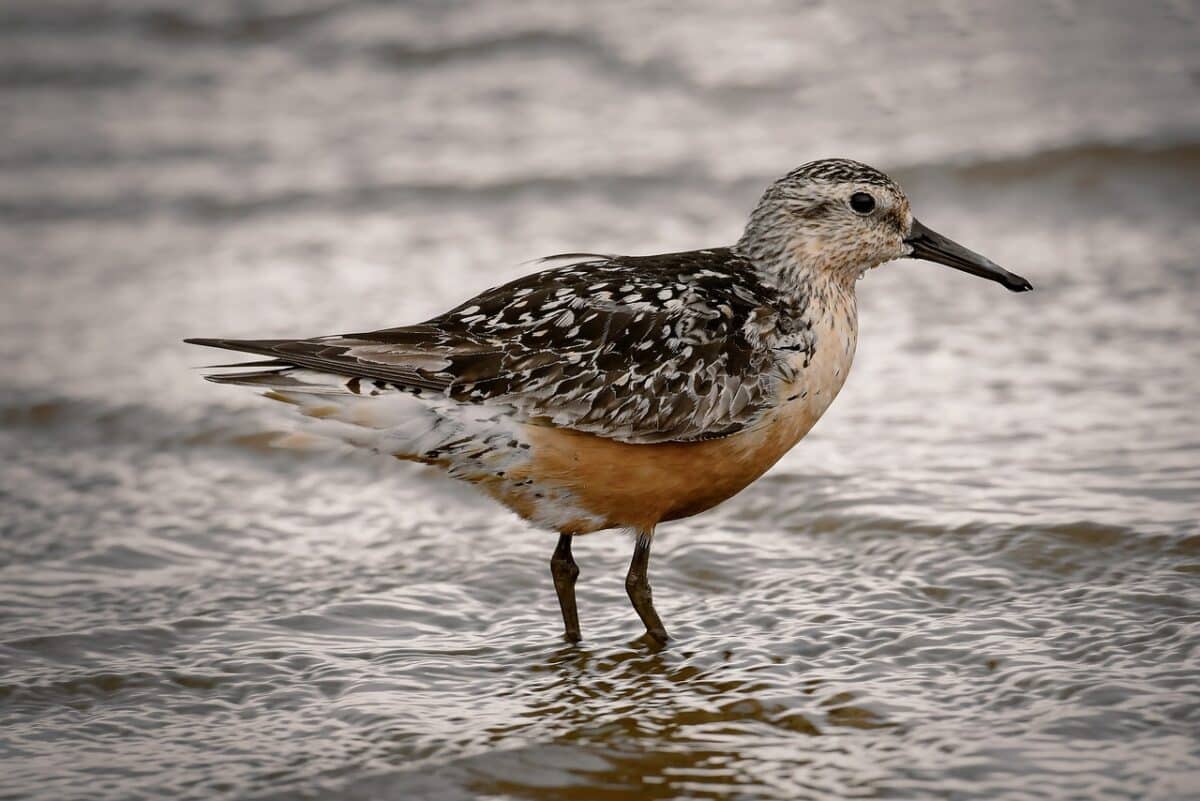
Both male and female Red Knots participate in incubating their eggs. During the breeding season, they produce less scented wax compared to other times. In species where only females incubate, males do not alter the composition of the wax they produce. When Red Knots consume mollusks, they swallow the shells and crush them in their gizzard, the specialized muscular part of their stomach. Studies have shown that Red Knots have the largest gizzards, relative to their weight, among all shorebirds.
During migration, Red Knots gather in massive numbers at traditional stopover sites. Delaware Bay is one important area during spring migration, where they feed on the eggs of spawning horseshoe crabs. On a single day, nearly 90% of the entire population of the Red Knot subspecies rufa can be present in the bay. The decline in available food due to the heavy harvesting of horseshoe crabs has played a role in their population decline.
Red Knots are captivating birds with incredible migration feats and unique adaptations. Let’s appreciate their beauty and join efforts to protect these remarkable shorebirds for generations to come!
Where to find Red Knots in North Dakota
They are majorly found in the high arctic regions of the North Dakota region. They are also found in Dry tundra regions and sunny and warm areas alongside other animals in North Dakota.
Summary in Animals in North Dakota
In the captivating landscapes of North Dakota, you’ll witness the majestic bison roaming, the graceful deer and impala leaping, and the powerful hawks soaring through the skies. North Dakota truly offers a glimpse of heaven for wildlife enthusiasts. Immerse yourself in the wonders of nature and get up close (well, not too close!) and personal with the diverse wildlife of North Dakota. And that’s not all—this region is also dotted with numerous lakes and water areas, adding to the allure and richness of the local ecosystem.
If you enjoyed reading the above on North Dakota animals, you are almost obligated to read about South Dakota. All jokes aside, feel free to check out our articles on New Jersey and North Carolina animals next!
Frequently Asked Questions (FAQs)
North Dakota is home to a diverse range of wildlife. Some notable animals found in the state include bison, pronghorn, white-tailed deer, coyotes, pheasants, wild turkeys, and various waterfowl species
North Dakota boasts a rich variety of wildlife. In addition to the animals mentioned earlier, the state is also home to elk, mountain lions, black bears, gray wolves, bobcats, raccoons, badgers, and numerous bird species.
The largest animal in North Dakota is the American bison, also known as the buffalo. These magnificent creatures can weigh up to 2,000 pounds and are an iconic symbol of the state.
No, grizzly bears are not found in North Dakota. They primarily inhabit the northwestern United States, including Montana, Wyoming, and Idaho.
While North Dakota does not have a resident population of bears, occasional sightings of black bears have been reported in the state. These sightings are relatively rare, as the black bear population in North Dakota is small and transient.
North Dakota is known for various reasons. It is famous for its vast prairies, agricultural productivity, scenic beauty, rich Native American heritage, and the historic Lewis and Clark expedition, which passed through the state.
North Dakota is known for its:
1) Agricultural productivity, particularly in the production of wheat, corn, and soybeans.
2) Scenic beauty, including Badlands National Park and the Theodore Roosevelt National Park.
3) Native American heritage and cultural significance.
4) Historic landmarks and sites, such as the Knife River Indian Villages and the Fort Union Trading Post.
5) Friendly and welcoming communities that embrace a strong sense of community spirit.
People choose to live in North Dakota for various reasons. The state offers a high quality of life, with affordable housing, low crime rates, a strong sense of community, and abundant outdoor recreational opportunities. Additionally, North Dakota’s economy, driven by agriculture, energy production, and technology sectors, provides employment opportunities and economic stability.
- 4 Best Places to Swim, Snorkel, or Dive with Orcas - April 16, 2024
- Tiger Safari: The Complete Guide - April 16, 2024
- Top 10 Cutest Fish in the World - April 15, 2024





